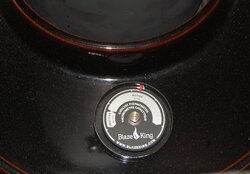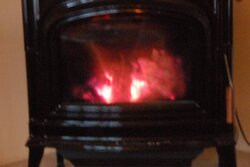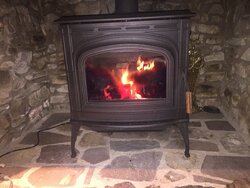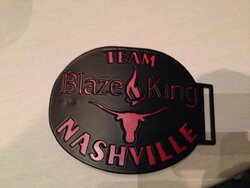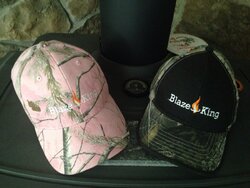I'm going to have to learn some techniques from you guys, if I have any hope of successfully using this ash bung thing. I pulled the plug, and tried getting some ash to go down the hole, for the first time tonight. I ended up with more coals than ash in the pan. [snip] can someone share some light?
No, I don't sweep my hearth every chance I get.
The one at the back came with my Ashford 30, may I say 30.0? Nominal 1/2", 90 degree angle on the end, it is the one tool I use 90% of the time. I have heard the wrangling tools with the 30.1s have a 45 degree bend on the end. If I couldn't get the hang of that before my wife left town for a weekend I would heat that sucker up to glowing red right in the stove while I was burning down coals, drag it down to the garage and hammer it over to 90 degrees. You got an anvil, right? Then water quench it, heat it again to dull yellow and then let it cool over night buried in the ash bin.
Not pictured, I got a 35 gallon galvanized trash can out in the front yard. All that goes in it is ashes out of the stove, takes about four cords worth of ashes to fill it. Bungeee cord to hold the lid down when the wind kicks up.
Also not pictured, I got a dedicated oven mitt for carrying that little box inside the ashdrawer out to the galvanized trash can.
That sifter thing in the middle I built from scratch, useless garbage. The holes are way too small. If I make another one, probably won't, I'll use expanded steel with holes in it about 1x3 inches. Straight handle on a flat sheet, complete tool would lie flat on a counter top, just push everything to the back, shovel out the ashes left behind at the front of the stove, pull everything forward, repeat as needed.
The other thing I got at my local stove emporium. About all I do with it is use the flat edge (down as pictured) to scrape ashes through the little hole into the drawer. It works good for that. 'Wood stove rake" will hit on google and get you some pictures. I have been eyeballing the bow rakes in the kid's sizes in the Lowes-Depot lawn department. tack weld a piece of sheet metal on the bow so I can turn it 180 degrees and have either a flat scraper or a rake with 1/4" tines on 1" centers. Don't want one bad enough to pay eight bucks and the electric bill for plugging in the spot welder.
The thing is, hanging out in front of the stove with the door open and a bunch coals burning down is a very hot place to be. I am pretty much to the point where I just use the wrangling tool to push the big (soft ball sized) coals to the back and lift the bung out, and then scrape ash and whatever coals will fit down into the drawer and get it over with.
Once that is done, wrangle the big coals forward, scrape the ash away from the back wall and reload. I have noticed that scraping the old ash out of the back corners of the stove tends to make the hair on my arms shorter.
Stove runs better with a bit of ash on the floor anyway.
I do vacuum the stove out long about June or so when I don't have to worry about setting the vac on fire.
I will say I get a lot less ash on my DVD player using the bung hole compared to shoveling into a bucket. I do use the tip of the wrangling tool to scrape the rim of the bunghole clean so the bung fits back down in there real nice on the first try.
On my hearth I still have the set of tongs that came with the fireplace tool set, use those about once annually. I took the fireplace poker to the dump to protect my firebricks from the kids. Kept the broom and flat shovel tool for the hearth too, but I just can't get worked up about keeping the hearth surgically clean.
All I try to do with ash removal is take enough ash to make room for fresh splits, and leave enough coals that I can hot reload. Having a few chunks of charcoal in the ash bin for the tomatoes next spring is no big deal.


